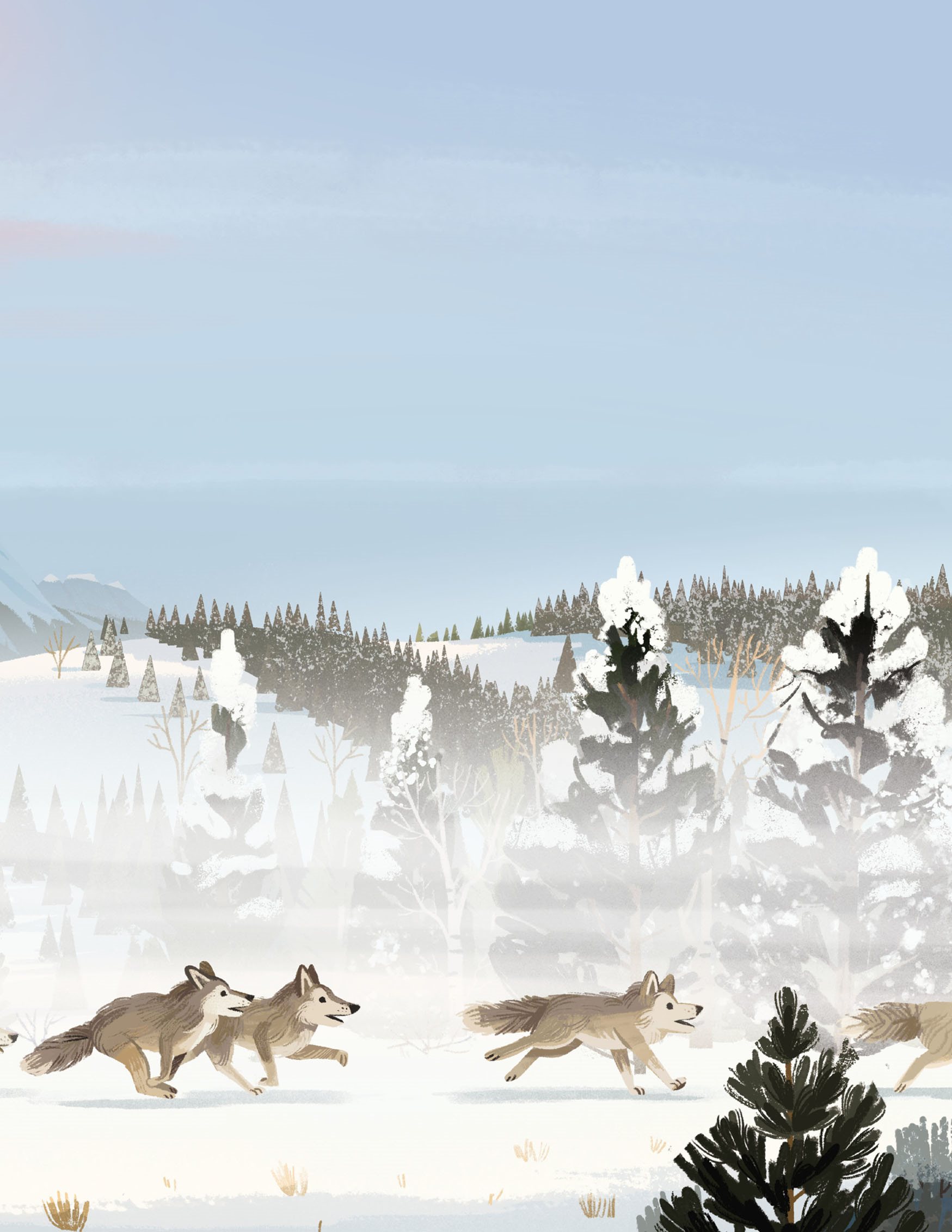Jude Isabella writes about science and the environment for readers big and small. She was the managing editor of YES MAG , Canadas science magazine for kids, and is now the editor in chief of Hakai magazine. She is also the author of The Red Bicycle . Jude lives in Victoria, British Columbia. Visiting Yellowstone National Park to watch wolves in action was a dream come true.
Kim Smith is a bestselling illustrator of several childrens books. She has also illustrated childrens video games, puzzles, animation, 3-D displays, posters and magazines. She lives in Calgary, Alberta, with her husband and their border terrier, Whisky. Kim hopes to one day howl like a wolf and have one call back.
TABLE OF CONTENTS
Yellowstone National Park is almost 9000 km (3500 mi) nearly three times the size of the state of Rhode Island!
A city park, a beach, a forest, a desert. What do they have in common?
They are full of living things that interact with one another and their environment . Take, for instance, a city park. It may be full of soil, trees, grasses, shrubs, flowers, insects, gray squirrels, birds and people. And each has a relationship with the other. They are part of an ecosystem, a web of connections between the living and non-living.
Every member of this park affects all the others. For example, if there was no soil, there would be no trees. Without trees, where would the squirrels find nuts to eat? Where would they den? And where would the birds build their nests?
Now take away the insects. What would pollinate the flowers? What would the birds eat? What would help decompose dead things?
AN UNINTENTIONAL EXPERIMENT
And if the people who tend the park were gone? What would happen to the ecosystem then?
If any one part of the web disappears, the entire ecosystem can change.
So, what if you could do a simple experiment? What if you really could take away one important member and watch what happens?
It was an unintentional experiment, but thats just what occurred in Yellowstone National Park.
First declared a national park in 1872, Yellowstone is a complex ecosystem. There are tiny things and big things, furry things and scaly things, stationary things and mobile things. All insects, plants and animals are part of the community of the living. They are neighbors that affect one another, directly and indirectly.
One of those neighbors, however, went missing for seventy years wolves.
TAMING THE WILD
In the late 1800s, the American government offered money a bounty to encourage people to hunt top predators: cougars, grizzly bears and wolves. The goal was to tame the West, the heart of cattle ranching, and rid the landscape of all threats to livestock. The result: hunters killed so many wolves that by 1926 no wolf packs were left in Yellowstone National Park.
Wolves are a keystone species . And the absence of a keystone species affects the ecosystem, both directly and indirectly.
In Yellowstone, wolves directly affected elk by eating them. But they indirectly affected many other living things, too aspen trees, coyotes, songbirds and beetles, to name just a few. And they also affected non-living things, such as the soil and the stream bank.
A Missing Link
Wolves are top or apex predators . When such an important member of an ecosystem goes missing, many other living things are indirectly affected, causing a chain reaction of events. This is called a trophic cascade .
A trophic cascade works in the opposite direction, too. Reinstating the missing link can also cause a chain reaction.
Wolves
Coyotes
Bears
Bison
Berries
Birds
Invertebrates
Elk
Pronghorn
Small mammals
Scavengers
Woody plants and grasses
Beavers
Streams
Direct and Indirect Effects of the Wolf
Indirect effect
Direct effect
A network of food chains makes up a food web . Yellowstone's food web is made up of hundreds of different species, a few of which are shown at right.
Without wolves, there was a break in one of Yellowstones food chains, which led to an avalanche of changes to the food web.
No wolves, and fewer bears and cougars, meant that their prey faced less danger. In Yellowstone, for example, wolves helped control the elk population. With no animals to hunt them, elk herds grew. And since elk are herbivores , they began browsing on the parks trees and plants in record numbers.
Many herbivores nibbling their way across a landscape will eventually transform it.
THE FOOD WEB
Within an ecosystem, wolves apex predators sit at the top of the food chain . A food chain can be shown as a simple pattern, a straight line of one organism eating another.
Its Elemental
Remember, every ecosystem is also affected by other natural forces climate and weather, for example and how they change daily, seasonally, year to year, decade to decade and century to century.
Plant
Elk
Wolf
Bison
Grasses
Wolf
Elk
Yellowstone Food Web
Grizzly bear
Woody plants
Berries
Gopher
Beaver
Snowshoe hare
Mouse
Coyote
Scavengers

























